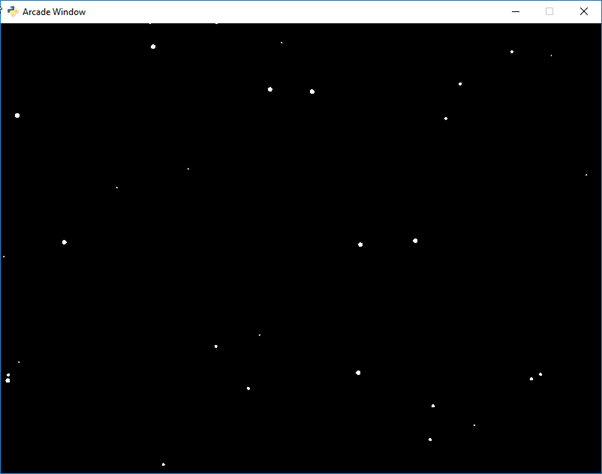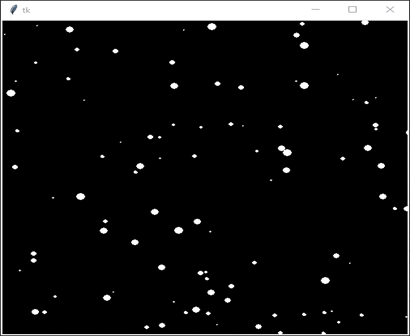Display snowflakes falling using arcade library in Python
arcade library is a Python library for creating 2D arcade style video games and simulations. If you want to use the arcade library to create a snowing effect, you can first create a new arcade window and set a dark blue background color to represent the night sky.
Using the arcade library in Python
The arcade library is a Python library used for developing 2D games and applications. It provides a simple interface to create interactive graphics and animations. In this article, we'll use the arcade library to create a simple snowfall animation.
To get started, we need to install the arcade library. You can do this by running the following command in your terminal or command prompt −
pip install arcade
Once the installation is completed, we can start writing our code. Here's a simple program that displays snowfall −
import arcade
import random
SCREEN_WIDTH = 800
SCREEN_HEIGHT = 600
SNOWFLAKE_SIZE = 64
class Snowflake:
def __init__(self):
self.x = random.randrange(SCREEN_WIDTH)
self.y = SCREEN_HEIGHT + SNOWFLAKE_SIZE
self.speed = random.randrange(5, 20)
self.angle = random.uniform(0, 2 * 3.1415)
def update(self):
self.x += self.speed * math.sin(self.angle)
self.y -= self.speed * math.cos(self.angle)
if self.y < -SNOWFLAKE_SIZE:
self.y = SCREEN_HEIGHT + SNOWFLAKE_SIZE
self.x = random.randrange(SCREEN_WIDTH)
def draw(self):
arcade.draw_circle_filled(self.x, self.y, SNOWFLAKE_SIZE, arcade.color.WHITE)
class Snowfall(arcade.Window):
def __init__(self, width, height):
super().__init__(width, height, "Snowfall")
arcade.set_background_color(arcade.color.BLUE_GRAY)
self.snowflakes = []
for i in range(100):
self.snowflakes.append(Snowflake())
def on_draw(self):
arcade.start_render()
for snowflake in self.snowflakes:
snowflake.draw()
def on_update(self, delta_time):
for snowflake in self.snowflakes:
snowflake.update()
if __name__ == "__main__":
window = Snowfall(SCREEN_WIDTH, SCREEN_HEIGHT)
arcade.run()
Output

Next, you can create a list of snowflakes, where each snowflake is represented as a tuple of (x, y, size) values. The x and y values represent the snowflake's position on the screen, and the size value represents the snowflake's size.
On each frame of the game loop, you update the position of each snowflake by adding a small random amount to its y-value. You can also check if the snowflake has fallen from the bottom of the screen, and if so, reset its position to a random x value at the top of the screen.
Finally, you can draw each snowflake on the screen using the arcade.draw_circle_filled() function, which accepts (x, y) position and size values as parameters.
Let's go over the code step-by-step.
First, we import the arcade library and the random module, which we'll use to generate random values for the snowflakes. We also define some constants: SCREEN_WIDTH and SCREEN_HEIGHT, which define the size of our window, and SNOWFLAKE_SIZE, which defines the size of our snowflakes.
Next, we define a Snowflake class. This class represents a single snowflake. In the constructor, we generate random values for the snowflake's position, speed, and angle. The update() method updates the snowflake's position based on its speed and angle. If the snowflake falls off the bottom of the screen, we reset its position to the top of the screen. The draw() method draws the snowflake on the screen using the arcade.draw_circle_filled() function.
After that, we define a Snowfall class. This class represents our main application window. In the constructor, we set the background color to blue-gray and create a list of 100 snowflakes. In the on_draw() method, we iterate over the list of snowflakes and call each snowflake's draw() method. In the on_update() method, we iterate over the list of snowflakes and call each snowflake's update() method.
Finally, we create an instance of the Snowfall class and call arcade.run() to start the application.
This code creates a Snowflake class to represent each snowflake, and a SnowfallGame class to manage the game loop and draw the snowflakes on the screen. The on_draw() method is called each frame to draw the snowflakes, and the on_update() method is called each frame to update the position of the snowflakes. The arcade.run() function starts the game loop and keeps the window open until the user closes it.
That's it! When you run the program, you should see a window with snowflakes falling on the screen.
In addition, Python provides a turtle drawing function, and we can use turtle drawing to achieve the snowflake effect shown below.

The above is the detailed content of Display snowflakes falling using arcade library in Python. For more information, please follow other related articles on the PHP Chinese website!

Hot AI Tools

Undresser.AI Undress
AI-powered app for creating realistic nude photos

AI Clothes Remover
Online AI tool for removing clothes from photos.

Undress AI Tool
Undress images for free

Clothoff.io
AI clothes remover

Video Face Swap
Swap faces in any video effortlessly with our completely free AI face swap tool!

Hot Article

Hot Tools

Notepad++7.3.1
Easy-to-use and free code editor

SublimeText3 Chinese version
Chinese version, very easy to use

Zend Studio 13.0.1
Powerful PHP integrated development environment

Dreamweaver CS6
Visual web development tools

SublimeText3 Mac version
God-level code editing software (SublimeText3)

Hot Topics
 PHP and Python: Different Paradigms Explained
Apr 18, 2025 am 12:26 AM
PHP and Python: Different Paradigms Explained
Apr 18, 2025 am 12:26 AM
PHP is mainly procedural programming, but also supports object-oriented programming (OOP); Python supports a variety of paradigms, including OOP, functional and procedural programming. PHP is suitable for web development, and Python is suitable for a variety of applications such as data analysis and machine learning.
 Choosing Between PHP and Python: A Guide
Apr 18, 2025 am 12:24 AM
Choosing Between PHP and Python: A Guide
Apr 18, 2025 am 12:24 AM
PHP is suitable for web development and rapid prototyping, and Python is suitable for data science and machine learning. 1.PHP is used for dynamic web development, with simple syntax and suitable for rapid development. 2. Python has concise syntax, is suitable for multiple fields, and has a strong library ecosystem.
 PHP and Python: A Deep Dive into Their History
Apr 18, 2025 am 12:25 AM
PHP and Python: A Deep Dive into Their History
Apr 18, 2025 am 12:25 AM
PHP originated in 1994 and was developed by RasmusLerdorf. It was originally used to track website visitors and gradually evolved into a server-side scripting language and was widely used in web development. Python was developed by Guidovan Rossum in the late 1980s and was first released in 1991. It emphasizes code readability and simplicity, and is suitable for scientific computing, data analysis and other fields.
 Python vs. JavaScript: The Learning Curve and Ease of Use
Apr 16, 2025 am 12:12 AM
Python vs. JavaScript: The Learning Curve and Ease of Use
Apr 16, 2025 am 12:12 AM
Python is more suitable for beginners, with a smooth learning curve and concise syntax; JavaScript is suitable for front-end development, with a steep learning curve and flexible syntax. 1. Python syntax is intuitive and suitable for data science and back-end development. 2. JavaScript is flexible and widely used in front-end and server-side programming.
 Can vs code run in Windows 8
Apr 15, 2025 pm 07:24 PM
Can vs code run in Windows 8
Apr 15, 2025 pm 07:24 PM
VS Code can run on Windows 8, but the experience may not be great. First make sure the system has been updated to the latest patch, then download the VS Code installation package that matches the system architecture and install it as prompted. After installation, be aware that some extensions may be incompatible with Windows 8 and need to look for alternative extensions or use newer Windows systems in a virtual machine. Install the necessary extensions to check whether they work properly. Although VS Code is feasible on Windows 8, it is recommended to upgrade to a newer Windows system for a better development experience and security.
 How to run sublime code python
Apr 16, 2025 am 08:48 AM
How to run sublime code python
Apr 16, 2025 am 08:48 AM
To run Python code in Sublime Text, you need to install the Python plug-in first, then create a .py file and write the code, and finally press Ctrl B to run the code, and the output will be displayed in the console.
 Can visual studio code be used in python
Apr 15, 2025 pm 08:18 PM
Can visual studio code be used in python
Apr 15, 2025 pm 08:18 PM
VS Code can be used to write Python and provides many features that make it an ideal tool for developing Python applications. It allows users to: install Python extensions to get functions such as code completion, syntax highlighting, and debugging. Use the debugger to track code step by step, find and fix errors. Integrate Git for version control. Use code formatting tools to maintain code consistency. Use the Linting tool to spot potential problems ahead of time.
 Where to write code in vscode
Apr 15, 2025 pm 09:54 PM
Where to write code in vscode
Apr 15, 2025 pm 09:54 PM
Writing code in Visual Studio Code (VSCode) is simple and easy to use. Just install VSCode, create a project, select a language, create a file, write code, save and run it. The advantages of VSCode include cross-platform, free and open source, powerful features, rich extensions, and lightweight and fast.






